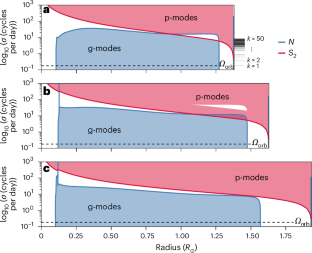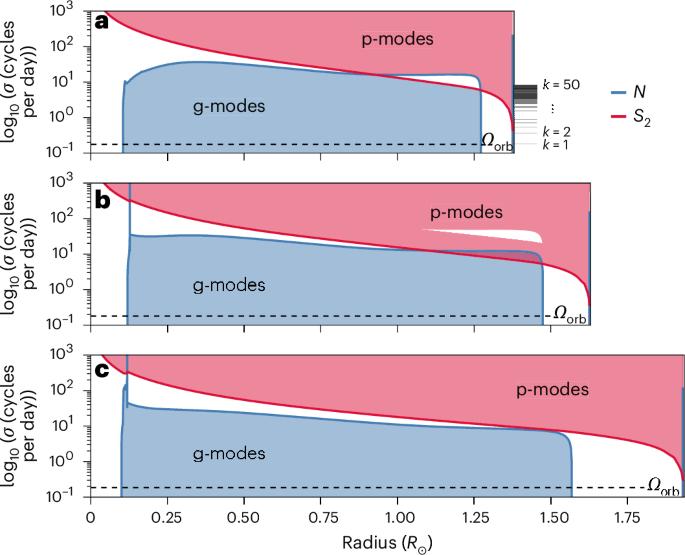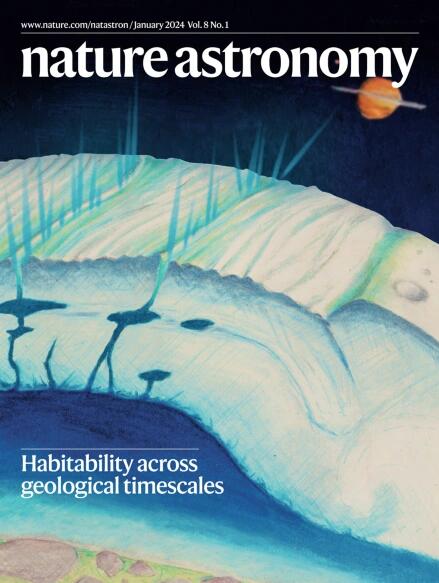The coevolution of migrating planets and their pulsating stars through episodic resonance locking
IF 12.9
1区 物理与天体物理
Q1 ASTRONOMY & ASTROPHYSICS
引用次数: 0
Abstract
Hot Jupiters are expected to form far from their host star and move to a close-in, circular orbit through a smooth, monotonic decay due to mild and constant tidal dissipation. Yet, systems exhibiting planet-induced stellar pulsations have recently been found, suggesting unexpectedly strong tidal interactions. Here we combine stellar evolution and tide models to show that dynamical tides raised by eccentric gas giants can excite chains of resonance locks with several modes, which enriches the dynamics seen in single-mode resonance locking of circularized systems. These series of resonance locks yield orders of magnitude larger changes in eccentricity and harmonic pulsations relative to those expected from a single episode of resonance locking or non-resonant tidal interactions. Resonances become more frequent as a star evolves off the main sequence, which provides an alternative explanation for the origin of some stellar pulsators and leads to the concept of ‘dormant migrating giants’. Evolution trajectories are characterized by competing episodes of inward and outward migration and the spin-up or spin-down of the star, which are sensitive to the system parameters. This is a new challenge in modelling migration paths and in contextualizing the observed populations of giant exoplanets and stellar binaries. This sensitivity, however, offers a new window for constraining the stellar properties of planetary hosts through tidal asteroseismology. A state-of-the-art model for planet–star interactions shows that migrating planets may coevolve with their pulsating stars through episodic resonances that drive substantial orbital migration and produce detectable tidal oscillations.


通过偶发共振锁定迁移行星及其脉动恒星的共同进化
热木星预计会在远离宿主恒星的地方形成,并在温和而持续的潮汐耗散作用下,通过平滑的单调衰减移动到一个近距离的圆形轨道上。然而,最近发现了一些表现出行星诱发恒星脉动的系统,这表明潮汐相互作用出乎意料地强烈。在这里,我们将恒星演化和潮汐模型结合起来,证明偏心气态巨行星引发的动力潮汐可以激发具有多种模式的共振锁链,这丰富了环化系统单模式共振锁链的动力学。与单次共振锁定或非共振潮汐相互作用产生的变化相比,这一系列共振锁定产生的偏心率和谐波脉动变化要大得多。共振会随着恒星脱离主序而变得更加频繁,这为某些恒星脉动器的起源提供了另一种解释,并引出了 "休眠迁移巨星 "的概念。演化轨迹的特点是内向和外向迁移以及恒星自旋上升或自旋下降的竞争性发作,这对系统参数很敏感。这对于模拟迁移路径以及将观测到的巨型系外行星和恒星双星群与实际情况联系起来是一个新的挑战。不过,这种敏感性为通过潮汐星震学制约行星宿主的恒星特性提供了一个新的窗口。
本文章由计算机程序翻译,如有差异,请以英文原文为准。
求助全文
约1分钟内获得全文
求助全文
来源期刊

Nature Astronomy
Physics and Astronomy-Astronomy and Astrophysics
CiteScore
19.50
自引率
2.80%
发文量
252
期刊介绍:
Nature Astronomy, the oldest science, has played a significant role in the history of Nature. Throughout the years, pioneering discoveries such as the first quasar, exoplanet, and understanding of spiral nebulae have been reported in the journal. With the introduction of Nature Astronomy, the field now receives expanded coverage, welcoming research in astronomy, astrophysics, and planetary science. The primary objective is to encourage closer collaboration among researchers in these related areas.
Similar to other journals under the Nature brand, Nature Astronomy boasts a devoted team of professional editors, ensuring fairness and rigorous peer-review processes. The journal maintains high standards in copy-editing and production, ensuring timely publication and editorial independence.
In addition to original research, Nature Astronomy publishes a wide range of content, including Comments, Reviews, News and Views, Features, and Correspondence. This diverse collection covers various disciplines within astronomy and includes contributions from a diverse range of voices.
 求助内容:
求助内容: 应助结果提醒方式:
应助结果提醒方式:


